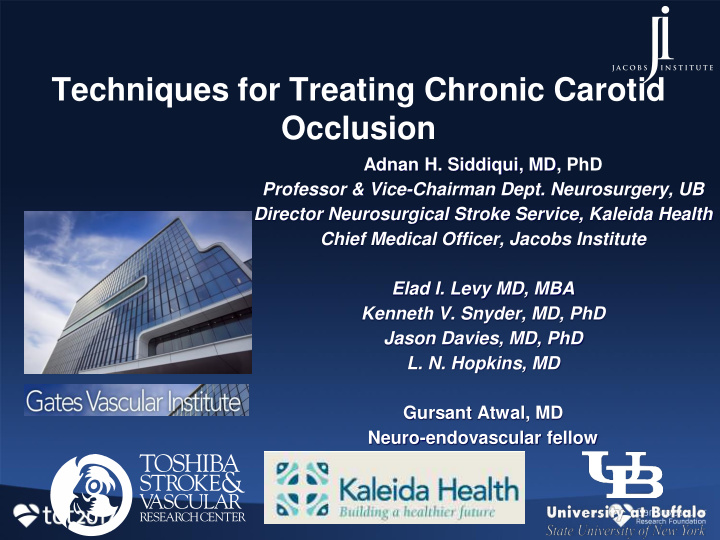



Techniques for Treating Chronic Carotid Occlusion Adnan H. Siddiqui, MD, PhD Professor & Vice-Chairman Dept. Neurosurgery, UB Director Neurosurgical Stroke Service, Kaleida Health Chief Medical Officer, Jacobs Institute Elad I. Levy MD, MBA Kenneth V. Snyder, MD, PhD Jason Davies, MD, PhD L. N. Hopkins, MD Gursant Atwal, MD Neuro-endovascular fellow
Disclosures Research Grants: Co-investigator: NINDS 1R01NS064592-01A1, Co-investigator: NIBIB 5 R01 EB002873-07 , Co-investigator: NIH/NINDS 1R01NS091075, Co- investigator: NIH-NICHHD R01 HD-04483101 Financial Interest: StimSox, Valor Medical, Neuro Technology Investors, Cardinal, Medina Medical, Buffalo Technology Partners, Inc., International Medical Distribution Partners Consultant: Codman & Shurtleff, Inc., Medtronic, GuidePoint Global Consulting, Penumbra, Stryker, MicroVention, W.L. Gore & Associates, Three Rivers Medical, Inc., Corindus, Inc., Amnis Therapeutics, Ltd., CereVasc, LLC, Pulsar Vascular, The Stroke Project, Cerebrotech Medical Systems, Inc., Rapid Medical, Neuroavi, Silk Road Medical, Rebound Medical, Lazarus (acquired by Medtronic), Medina Medical (acquired by Medtronic), Reverse Medical (acquired by Medtronic), Covidien (acquired by Medtronic), Advisory Board: Intersocietal Accreditation Committee National Steering Committees/PI: Penumbra: 3D Separator Trial, COMPASS Trial, INVEST Trial; Covidien (Now Medtronic): SWIFT PRIME and SWIFT DIRECT Trial; MicroVention: FRED Trial, CONFIDENCE Study; LARGE Trial, POSITIVE Trial, No consulting salary arrangements. All consulting is per project and/or per hour.
Chronic Carotid Occlusion • 5-7 % risk of Stroke • Can be as high as 28 % Pts with increased Oxygen extraction Hauck et al. Neurosurgery E1154 | VOLUME 67 | NUMBER 4 | OCTOBER 2010
Chronic Carotid Occlusion: Considerations • Assessment of Cerebrovascular Reserve • Site of Occlusion • Collateral flow • Length of the occluded segment • Extracranial vs Extra and Intracranial occlusion • Protection From Distal Emboli • BP control to prevent reperfusion syndrome
Chronic Carotid Occlusion: Techniques 6 cases: no complications or restenosis at 1 year
Chronic Carotid Occlusion: Techniques • 3 sheath system • 10F Right Femoral arterial, 8F Right Femoral Venous, 5F Left Femoral Arterial • Balloon Guide catheter on the side of the occlusion connected to Venous sheath via Filter for Flow Reversal • Diagnostic catheter on the contralateral sided to visualize retrograde flow • Balloon catheter (Percusurge Guard Wire) placed in ECA to stop ECA flow • Lesion crossed with GT (016) or SuperHard (014) exchange length wire and balloon (Gateway) catheter under flow reversal • Balloon inflated from distal to proximal • Filter type catheter (MintCatch) placed in the Guide to aspirate the debris • Precise stent deployed
Chronic Carotid Occlusion: Techniques
Chronic Carotid Occlusion: Techniques Revascularized 7 of 8 cases No clinical complications 75% witrh asymptomatic DWI hits
Chronic Carotid Occlusion: Techniques
Chronic Carotid Occlusion
Chronic Carotid Occlusion
CTP with and without Diamox • Stress test for the brain
CBV Without diamox CBF TTP
CBV With diamox TTP CBF
NOVA qMRA • Non-invasive Optimal Vessel Analysis • Uses PC MRI technique Proportionality of flow velocity and phase shift in the signal of flowing blood Calculates flow rate Indicates the direction of flow • US Food and Drug Administration 510(k) clearance in 2002 Flow resistance = ~1/r^4
NOVA MRA 4D Visualization
Watershed infarcts
Watershed infarcts
Watershed infarcts
Chronic Carotid Occlusion: Buffalo Protocol
Chronic Carotid Occlusion: Buffalo Protocol • 9F sheath • MoMA (Proximal Protection System) • 5F MPA catheter for support to cross the lesion or Quick cross • May also use Pilot 0.14 wire if there is a taper • Angled 035 exchange length Glidewire to cross the lesion under flow arrest then exchange for 014 spartacore wire • IVUS to confirm the wire in true lumen can be used • Wall stent in the cervical ICA • Rigid Cavernous segment occlusion can be crossed with Gold tip microwire and Nautica (rigid microcatheter) • Balloon mounted Coronary stents for Petro Cavernous ICA or Self expanding Wingspan stent
Chronic Carotid Occlusion: Case Example • 54M presented with dysarthria and mild right hemiparesis, NIH 2 • CTSS demonstrated Lt ICA occlusion, chronic for 3 years based on prior CTA • Hypoperfusion in the Lt ICA territory on CTP • Patchy hypodensities in Lt MCA territory on CT head w/o
Chronic Carotid Occlusion: Case Example Pre Op CBF showing hypoperfusion Post Op Hauck et al. Neurosurgery E1154 | CBF nearly symmetric VOLUME 67 | NUMBER 4 | OCTOBER 2010
Chronic Carotid Occlusion: Case Example • Did well post op • NIH 0 • Monitored in ICU for several days until BP controlled with oral anti hypertensive's • Discharged home
Chronic Carotid Occlusion: Case Example
Presentation MRI/DWI with L ICA occlusion • 8/20/09
CTP @ Presentation
DEVICES USED • 1. A 6 Fr sheath. • 2. 7 and 9 Fr dilators • 3. Stiff 35 exchange. • 4. VTK. • 5. 9F Gore flow reversal system • 6. Heparin 3500 / ACT 484 + 1600 / ACT 272. • 7. Excelsior 1018, Gold tip, All Star micro wire. • 8. IVUS. • 9. Wallstent 6 x 22 and 6 x 22. • 10. Aviator Plus balloon 6 x 30. • 11. All Star micro wire and 8 Fr Angio-Seal.
8/21/09
Plan 1. Do Nothing 2. Medical Management 3. Open surgical repair 4. Percutaneous balloon 5. Endovascular repair
MPA
ECA: Hypoechogenic ICA: Hyper (dye stasis) with hypo (intraluminal thrombus)
Filling Defect! ?Thrombus
No Intraluminal Thrombus
• Hosp. Course: − POD#2 &4: NIHSS = zero − Patient was D/C home on ASA/Plavix
Conclusions • Rare to see a true chronic occlusion • Most now present acutely or subacutely • Ideal patient improves with hypertension • Establish angiography and collaterals • Ideal patient refills carotid retrogradely or anterogradely to petrous segment • Establish infarct volume MRI shows watershed hits • Establish compromised vascular reserve or steal with Diamox • Use proximal protection • IVUS prior to restoring anterograde flow
Thank you! Questions?
Recommend
More recommend